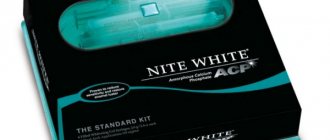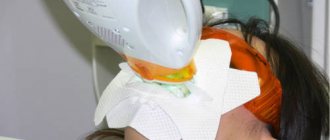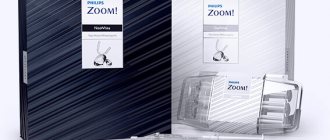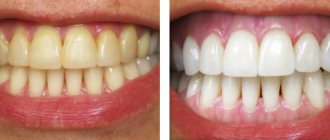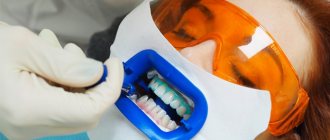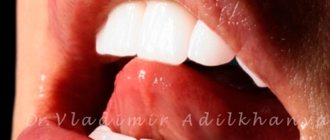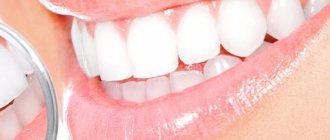The mechanism of this whitening method
What is oxygen teeth whitening? This is a method that involves the activation of hydrogen peroxide or urea. The fact is that under certain conditions (which are created using special means and methods, but more on that later), peroxide molecules split into water and atomic oxygen.
Oxygen atoms, in turn, actively penetrate the structure of enamel and dentin, bind to pigment molecules, make them water-soluble and literally clean them out of the pores. Thus, the pigmented areas become discolored, and the patient receives a snow-white smile.
Important! To achieve a high result, that is, lightening by many tones, ordinary peroxide from the pharmacy will not work. We need special products with a balanced composition and high concentration of active ingredients. They are usually produced in the form of special gels, which doctors apply to the enamel and activate. Or in the form of toothpaste, strips and pencils - with these types of products oxygen whitening can be carried out at home, but the effect will be lower than from office procedures, since they have a lower content of the active substance.
How long does the whitening effect last?
It is completely natural that after teeth whitening, new plaque will appear. The process of darkening the enamel itself takes a very long time. But it accelerates significantly if you consume coloring products such as coffee, tea, Coca-Cola, red wine, beets, etc.
Two factors influence how long the results last: your lifestyle and the permeability of your enamel. If you consume foods with coloring agents every day, you will significantly reduce your whitening results. If you have increased enamel permeability, then eating food with dyes will cause your teeth to yellow faster. Alas, it is impossible to know in advance what degree of permeability of tooth enamel you have.
Conclusion: if you have increased permeability of tooth enamel, and at the same time you often use dyes, then the whitening effect will last about six months. If you take little of the above substances and your teeth have low permeability, then whitening performed in the clinic will last for about two years.
How does oxygen activation occur?
As noted above, to carry out oxygen bleaching in order to lighten the enamel by many tones at once (5-12), peroxide alone in a high concentration is not enough. A catalyst is needed to break it down and release oxygen atoms. Dentists use various means as such an activator:
- chemical compounds and reagents,
- halogen, LED, ultraviolet, LED lamps and even conventional polymerization lamps (for example, Klox biophotonic technology): many doctors today consider cold lamps to be the best, since they produce so-called cold light with a temperature of about 37 degrees, which practically does not heat the enamel, which makes the procedure quite comfortable and painless,
- laser: acts very carefully, precisely, and at the same time has a disinfecting, anti-inflammatory and even strengthening effect.
What does a teeth whitening lamp look like?
Advice from Dr. Zubastik
You can whiten your teeth in different ways. Choose yours after consulting with your dentist.
Remember. Regardless of the method, the result will please you for a long time only if you carefully care for your oral cavity: brush your teeth morning and evening, use floss, and undergo preventive examinations.
A smile is your “calling card”. Let her be beautiful and inviting!
Tags: Amazing White, LED lamp, Yotuel, oxygen whitening, whitening
About the author: Dr. Zubastik
Typically, a toothache begins to subside on the way to the clinic and finally goes away after 10 minutes of sitting in line to see the dentist.
- Related Posts
- Veneers: pros and cons of installing onlays on teeth
- Aligners or braces: which is better?
- The best toothpastes for tartar: top 10
« Previous entry
Indications and contraindications for the procedure
The desire to make a snow-white smile, as well as yellowness, discoloration of teeth and stains on the enamel caused by food and drinks, wearing braces, smoking, some types of hypoplasia and fluorosis (spotted forms) are all reasons to consider oxygen whitening. But for the procedure to be effective and safe, the following contraindications must be excluded:
- age up to 18 years, pregnancy and breastfeeding,
- the presence of multiple restorations (fillings, crowns, dentures) in the smile area,
- untreated caries, pulpitis, periodontitis,
- acute inflammation of the gums and mucous membranes,
- erosions, wedge-shaped defect, severe forms of fluorosis and hypoplasia,
- increased sensitivity, abrasion of enamel, multiple cracks and chips,
- the period of orthodontic treatment, especially when the patient wears fixed systems like braces.
Contraindications
Absolute:
- allergy;
- high sensitivity of teeth;
- oncological diseases;
- advanced periodontitis.
Relative:
- pregnancy;
- braces;
- large old fillings;
- exacerbation of periodontitis, which is in the initial or middle stage.
Please note that after removing braces, it is advisable to wait 3-6 months for the enamel to strengthen, and only then lighten your teeth.
These contraindications are temporary, and after the pregnancy ends, the braces are removed, the doctor changes the fillings and relieves the exacerbation of gum disease, you can whiten your teeth with oxygen.
Methods of oxygen lightening of enamel
As for oxygen teeth whitening, people who want to transform their smile in this way have many different options that differ in cost and, naturally, in results. You can use professional methods, or you can give preference to home approaches.
Expert opinion
Victoria Nikolaevna Kashaeva
Specializations: Dental hygienist, therapist
Experience: 5+
“In essence, oxygen teeth whitening is not a separate or unique technique. It would be more correct to say that this is a general concept. Today, in almost all cases, products containing hydrogen or urea peroxide, which break down into oxygen atoms, are used to lighten enamel. The only difference is the concentration of the active substance, the composition of other components (the gel may contain fluorine, potassium, etc.), as well as the method of activating the peroxide.”
Professional ways
The largest group of methods based on the separation of oxygen atoms from peroxide is photobleaching. The catalysts here are lamps. And the most popular, safe and effective techniques include: ZOOM, Amazing White, Luma-Arch, Beyond Polus.
Laser whitening, when the gel applied to the enamel is activated by a laser beam, is deservedly in demand today. This technique is one of the safest, painless, allows you to work with complex defects and even improve the appearance of “tetracycline” teeth. True, the cost of procedures involving a laser is quite high, starting from 20 thousand rubles.
What does a laser whitening procedure look like?
Let's consider the most budget-friendly methods among professional ones. For example, chemical oxygen teeth whitening using the American Opalescence method. It is also carried out under the supervision of a doctor (but there are a variety of remedies for home use) and only after careful preparation. However, you shouldn’t expect too much effect here, a maximum of 4-6 tones. It is also important to understand that chemical methods, due to the emergence of safer and more comfortable ones, are gradually fading into the background, so dentists offer them less often.
Another fairly budget option is the so-called cosmetic lightening. Popular technology – Magic White. The peroxide gel is activated by an LED lamp. And the creator of the method assures that not only dentists, but also cosmetologists can carry out the procedures, which saves the patient’s time and money. Agreeing to this, you need to understand that cosmetologists cannot always competently assess the condition of the oral cavity of the person who contacts them, as well as exclude contraindications. In addition, cosmetologists will not be able to carry out preparations, for example, professional hygiene in order to remove bacterial plaque, which will be an obstacle to ideal whiteness.
There is also biophotonic technology "Klox". The creators of the method report that to carry out the procedures and activate hydrogen peroxide, all you need is a polymerization lamp, which is available in any dental office.
In cases where a patient goes to the dentist with discolored, pulpless (without nerve) teeth, the doctor can also offer intracanal (endodontic) whitening based on the action of peroxide and atomic oxygen.
Home methods and remedies
Again, professional products can be used for this purpose. Many well-known brands, for example, Zoom, Amazing White, Opalescence, produce products for home use, but emphasize that this requires preparation of the oral cavity and supervision by a dentist. At a minimum, a doctor should select and prescribe medications. Usually a special gel is included, which is applied to the enamel and kept according to the instructions. For the best effect, it is recommended to use the gel with the mouth guards included in the kit or purchased separately at the dentist.
Complete kit for whitening at home
Another option is stripes and pencils. For example, Crest strips, available in a wide range, are very popular, effective and relatively safe.
In addition, many people today choose a product such as toothpaste. True, you should be very careful here. If you want to carry out oxygen bleaching, then not all bleaching pastes are suitable for this. Most of them are based on mechanical action, when plaque is removed using abrasives included in the composition (for example, charcoal and bamboo charcoal). And you need to look for exactly those that contain hydrogen peroxide or carbamide. For example, ROCS[1] Pro Oxywhite (“Oxygen bleaching”).
But those who like to experiment with folk recipes try to lighten the enamel using pharmaceutical peroxide 3%. In fact, upon contact with air, oxygen is also released from it, but saliva very quickly neutralizes its effect. Due to the low concentration of the product and its rapid neutralization, the effect of such lightening will be minimal. You can read more about this in the feature article on the website.
Stages
Before the doctor decides to perform the procedure, he asks the patient about diseases and allergic reactions. Then prepares the oral cavity:
- identifies foci of caries, treats;
- treats periodontal diseases, if any are detected;
- replaces old fillings that have darkened or do not adhere well to the tooth surface.
Finally, the dentist will clean your teeth using ultrasound. It removes soft and hard deposits to prevent the appearance of new carious and inflammatory lesions.
Finally the preparation is complete.
The second stage begins - the whitening procedure itself. It includes:
- applying gel;
- use of LED lamp;
- rinsing off the gel and treating the teeth with a paste that protects the enamel from demineralization.
Often a three-time procedure is required (in one session). Each mini-stage lasts 15 minutes.
The patient then receives oral care recommendations and goes home. Weak sensitivity to cold and hot sometimes lasts for a couple of hours, then goes away.
Pros and cons of professional oxygen bleaching
If we are talking about professional products that are used under the supervision of a dentist, then the advantages are as follows:
- This is a choice of completely different methods,
- this is an achievement of high results - you can achieve enamel whitening by 10-12 shades (depending on its initial condition, color and the patient’s desire),
- it is safe for teeth and gums, taking into account contraindications and individual characteristics of the patient. Experienced doctors will not carry out the procedure without careful preparation, sanitation of the oral cavity, strengthening of enamel, without protective equipment (for example, liquid rubber dam for gums),
- it's fast: the effect is achieved in just 1 visit to the clinic.
The disadvantages include the relatively high cost of such procedures. You also need to be prepared for the fact that many patients’ teeth become very sensitive for some time after lightening. To make this go away faster and to minimize discomfort, you will need to strengthen the enamel with special pastes and avoid hot and irritating foods.
The disadvantages include the fact that in order to maintain a long-term effect, the patient will have to follow a “white” diet after the procedure, stop smoking and drinking red wine, and do not skip daily teeth brushing and professional hygiene. But again, all these rules are mandatory after any whitening method, even if we are talking about home remedies.
Teeth whitening prices
| Teeth whitening | |
| Services list | Price |
| Removing dental plaque with “DetartrineZ” paste (paste with abrasive zircon crystals, 1 tooth) | 250 |
| Ultrasonic removal of supragingival and subgingival dental plaque in the area of the 1st tooth | 200 |
| Removing soft plaque using the “Air-flow” method (1 tooth) | 300 |
| Deep fluoridation of tooth enamel | 150 |
| Remineralization of enamel “APADENTPRO” (1 tooth) | 250 |
| Clinical whitening “OpalescenceBoost” 40% (2nd jaw in the smile line) | 18 500 |
| Professional clinical whitening “Amazing-White” (USA, 45 min, 2 jaws in the smile line) | 17 500 |
| Home whitening “Opalescense” | 9 500 |
| Intra-canal whitening of the 1st tooth | 2 500 |
| Making individual trays for home whitening (from one jaw) | 6 000 |
| “Skyce” fixation (1 tooth) | 4 500 |
| Professional clinical whitening “ZOOM-4 WHITESPEED” (2 jaws in the smile line) | 30 000 |
Pros and cons of home remedies
If you use strips, pencils, paste, or just a regular bottle of peroxide from the pharmacy, which are used for oxygen bleaching, then the most obvious advantage here is budget savings. Also, if your oral cavity is in good enough condition, you regularly visit the dentist, and your approach is reasonable (if you do not carry out procedures frequently and follow the instructions), the likelihood of harming the enamel using such means is minimal. Thus, it is lower than with the unlimited use of abrasives with soda, coal, and lemon.
This is what teeth whitening strips look like
Another plus is that with strips and pencils, for example, you can also quite successfully lighten the enamel by 3-5 tones, which is more than enough for many people. The resulting color will definitely not be unnatural, too white.
As for the disadvantages, the following points must be taken into account:
- without prior consultation and examination by a dentist, you may overlook contraindications that are important to exclude for safe and effective whitening procedures,
- Not everyone needs to lighten the enamel by 3-5 tones. Some people want more, and only professional technologies can achieve this,
- there is a risk of injuring the enamel and gums.
Kinds
Oxygen whitening is divided into a session in the dentist’s office - the “office” option - and home whitening.
By the way, this is another advantage of the technique - the ability to get a satisfactory result at home, without visiting a doctor. Only a preliminary consultation is required to ensure there are no contraindications.
At the dental clinic you will be offered to whiten your teeth using:
- Amazing White Systems.
- Gentle Yotuel technique.
Amazing White Complex
In the first case, a gel containing up to 16% hydrogen peroxide is used.
Complex Yotuel
In the second, the gel contains only 7.5% of the active component. Patients whose teeth are sensitive to any manipulation use the second method, which also produces results. Home whitening is less effective. But the enamel will lighten by 5 tones. The developer provides such a guarantee.
For home whitening, purchase kits that include:
- gel;
- syringes;
- mouth guard;
- LED lamp.
Another option is the use of oxygen-containing pastes. The active element is released when the paste is combined with water.
In kits and pastes for “homework”, the percentage of peroxide or hydrogen peroxide is lower, and therefore the effect will not be as bright. Manufacturers reduce the oxygen percentage to make home remedies safe to use.
What is this procedure?
The name of the Zoom 4 procedure comes from the name of the system used to whiten tooth enamel. The Zoom system was developed in the United States, gained worldwide recognition and became widely used in other countries. Zoom 4 is the latest version of this system, allowing you to whiten your teeth without damaging the enamel. Its main advantage is an improved light source (LED) and three light output power modes, thanks to which the problem of dental hypersensitivity during and after the procedure has now been solved.
Endodontic whitening
This technique is used in case of darkening of a pulpless tooth (in which the nerve was previously removed). Endodontic whitening can correct the color of only one tooth if other methods have not given a positive result. After the diagnosis, the pulpless tooth is opened, the remains of the filling and all carious lesions are removed. An active gel is introduced into the cavity and closed with a temporary filling. It may take 3-4 visits to achieve results, so the entire process may take about 1 month. It is important that intra-canal whitening allows you to remove pigment from the inside and give the tooth a natural shade. In cases where only one tooth differs in color from all the others, this technique can be the most acceptable option for lightening the tooth and creating a harmonious smile.
Photobleaching
This is the most common method of teeth whitening. Its huge advantage is the durability of the effect. With the proper level of care, the whiteness will last up to 2 years!
This technique also uses whitening gels with the same composition, but in addition to them, a catalyst in the form of cold light is also used. For this purpose, special lamps were created, with the help of which the manipulation is performed quickly and very effectively. The most advanced photo whitening system is Beyond Polus, and it is the best way to professionally whiten your teeth. Essentially, the same chemical reaction occurs between the tooth and the gel, but thanks to the light, active oxygen penetrates much deeper into the enamel and removes more pigment. Therefore, the result of this procedure is lightening by 10-12 tones.
American corporation Beyond International Inc. declares that it has created a fundamentally new approach in this regard. Activation of the gel components in this case takes place under the influence of an LED lamp and halogen light. But unlike well-known photo-whitening techniques, such as ZOOM, overheating of the enamel-dentin layer of the tooth does not occur here. The lamp produces not warm, but cold light of the blue spectrum; when it hits the teeth, it additionally passes through 12 levels of protection and through special lenses that block harmful infrared radiation and protect you from ultraviolet radiation.
Description of the technique
To begin with, the doctor determines the existing color of the patient’s tooth enamel and reports on the possible results after the procedure. The patient's cheeks and lips are then isolated from the teeth. In this case, the gums need protection from burns when applying the active gel, so they are also isolated from the outer surface of the teeth. When the oral cavity is prepared, apply gel with peroxide, distribute it evenly over all teeth in the smile area and turn on the lamp. A new portion of the gel is applied every 20 minutes, one cycle takes 60-90 minutes.
The cost of this procedure is 25,000 rubles, and the result can last up to 2 years!
Zoom4 whitening is also widely used in dentistry; the only disadvantage of this procedure is the increased sensitivity of the teeth both during and after the procedure. This is due to the fact that Zoom lamps produce warm spectrum light, which leads to heating of the enamel.
Professional hygiene
Professional teeth cleaning in itself is not a whitening method, however, one of the bonuses of this service is the whitening of teeth by removing pigmented plaque. The first step is to remove hard dental deposits (tartar) using ultrasound, and then use AirFlow to cleanse the teeth of superficial pigmented plaque. Regular brushing allows you to maintain not only healthy teeth, but also the whitening effect for several years!
